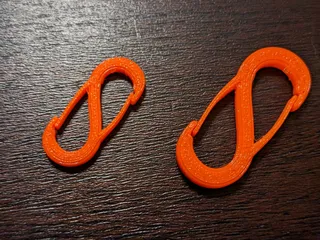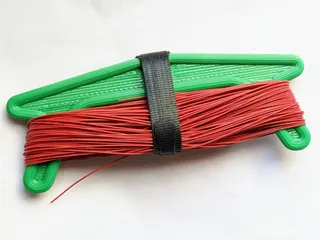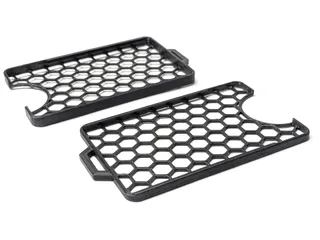Morse Code Paddle / CW Key
Descrizione
PDFBACKGROUND:
As an avid portable HF operator, regularly activating SOTA summits and parks for POTA, I have been disappointed with the performance, cost, and size of cheap morse code paddles. So, I designed my own.
For portable ops, or to mount it to a desk mount, consider also printing a Leg Strap/Base Plate to go with it.
Parts are kept to a minimum, and total cost per unit for a batch of 10 is less than $2 each! At 48 x 24 x 18 mm (1.9 x 1 x 0.7 in.), this little guy won't take up much space in your pack, but functions like a much bigger unit. Set screws allow independent adjustment of the throw and tension/resistance of each lever. The 3.5mm TRS jack allows connection to your radio with any standard Aux cable. Want to add a magnetic base? Stick three or four 10 x 2 mm magnets to the base with super glue.
BILL OF MATERIALS:
Links are Amazon Affiliate links - It costs you nothing more, but I get a few cents on the dollar from Amazon if you purchase through these links.
| Mandatory Items | Qty | Source |
| 3d Printed Levers | 1 | Print it using the attached STL |
| 3d Printed Base | 1 | Print it using the attached STL |
| 3d Printed Top | 1 | Print it using the attached STL |
| 3.5 mm TRS Panel Mount Jack | 1 | https://amzn.to/3Hadrd2 |
| M3 x 4 mm Set Screw | 4 | https://amzn.to/3ir8Mca |
| M3 x 4 mm Machine Screw | 1 | https://amzn.to/3uF4ZLb |
| 36 ga Wire (I like NiChrome for this) | 30 mm | https://amzn.to/3h2d0Xx |
| PETG Filament | ~12 g | https://amzn.to/3H9QN4p |
| Additional/Optional | ||
| Aux Cable (4 ft) | 1 | https://amzn.to/3XZ1IUo |
| 10 mm x 2 mm Magnets | 3 | https://amzn.to/3VYIxIp |
| Cyanoacrylate Glue | 1 tube | https://amzn.to/3h2dD3l |
TOOLS:
- 3d Printer capable of printing PETG
- 1.5 mm hex driver (https://amzn.to/3gX4sB8 or https://amzn.to/3ulV3X1)
- #1 Phillips head screwdriver (https://amzn.to/3HaQlD2)
- Tweezers (https://amzn.to/3BaOeex)
- Wire cutters or scissors you aren't worried about damaging (https://amzn.to/3VycZJK)
- Soldering iron (optional - you can build the paddle without this) (https://amzn.to/3P3bxgk)
ASSEMBLY:
1.) Print all the things.
I've included the GCode I use on a Prusa i3 Mk ii if you want to just download and hit “print.”
Print your parts for the assembly. Use PETG only! This design relies on the flexibility and elastic deformation capability of PETG. PLA will not work.
Use a perimeter width of 225% or less with a 0.4 mm nozzle to ensure two perimeters at the hinge. If there is only a single perimeter at the hinge, the slicer will likely make it a seam and weaken the lever assembly.
Supports should not be necessary for any of the prints.
You may need to clean up the openings of the bottom holes on the paddle levers if your first layer height results in some elephant's foot spreading. Also ensure the small “spring” levers on the bottom of the lever assembly are not bound to the outer levers.
2.) Attach 1" of wire to each of the side lugs of the 3.5 mm jack.
Do not attach wire to the ground (center) lug.
Use only 36 or 34 ga wire. Thicker wire will affect the paddle feel.
Ideally use steel or copper clad steel wire for durability. Magnet wire may work well enough, but is more likely to break. I like NiChrome wire because it is solderable, but very cut resistant.
If you don't have a soldering iron, twist the wire onto the lug, securing it through the hole, then wrap the wire tightly around the lug a few times before passing the wire through the hole one final time. This provides sufficient electrical connection without requiring solder. This can also allow the use of stainless steel wire.
3.) Flex the levers back and forth gently to loosen up the hinge.
Freshly printed levers are a bit too stiff, but PETG will fatigue and loosen up nicely with gentle, gradual flexing back and forth. I typically end up gradually flexing back and forth until I reach 45 deg throw on each lever. This allows the paddle feel to be adjusted very light.
4.) Install the 3.5 mm jack into the Lever print.
Insert the 3.5 mm jack into the center of the levers and secure through the larger hole with the nut that came with the jack.
Orient the jack with the ground lug centered and toward the bottom. This lug will get pinched between the machine screw and the plastic post it screws into.
5.) Snap the lever print onto the base.
If you encounter resistance, stop and carefully clean up the openings of the holes to ensure they are the proper size.
6.) Install the machine screw ground post.
Use a phillips head screwdriver to secure the machine screw to the center ground post of the Lever print. Pinch the ground lug of the 3.5 mm jack under the screw.
7.) Insert the wires into the small holes on the inside of the levers.
Insert the wires into the small holes that intersect the forward/higher 2.8 mm set screw holes until you see them extending through to the set screw hole, then push the wire into the set screw hole toward the center of the levers. Leave a little slack in the wire to the lug on the jack to allow the lever to move and flex unencumbered.
8.) Install the set screws.
Install the forward/higher set screws first, ensuring the set screws pinch the wires you inserted into the holes, securing them mechanically and making electrical contact. Screw in the set screws until they are about 1 mm beyond flush with the outer surface of the lever.
Install the rear/lower set screws. Screw in the set screws until they are flush with the outer surface of the lever.
9.) Snap on the top cover.
Carefully inspect the cover to identify the proper orientation. The rear portion has a raised center section that sits flush on the lever assembly.
10.) Adjust the paddle for optimal feel.
Adjust the paddle spring tension using the rear/lower set screws, and adjust the paddle throw using to front/higher set screws.
Get on the air and have some fun!
CAUTIONS:
Because this paddle relies on flexing plastic for the hinge, it has certain failure modes that make it easy to break if you apply force in the right spots. DO NOT pry up or down on the ends of the levers. While the levers are durable and can handle plenty of lateral pressure, pushing up or down on them will break them fairly easily. Keep this in mind as you pack them for carrying and storage. Perhaps I'll design an add-on protective cover at some point if this becomes too much of a problem.
DESIGN TWEAKS:
12/5/2022: Chamfered press fit holes for easier assembly. Added .3 mm height to front posts on bottom frame to level the final assembly height front/back. Back has two press fit joints which add about .3 mm height each, and front only has one.
12/6/2022: Thickened lever where the throw adjustment hole is to ensure shorter set screws have enough threads remaining in plastic. Added STL for larger levers.
12/28/2022: Moved the wire hole up slightly, shortened the height of the springs by .5mm to reduce interference with the jack for those who adjust for longer throw, and added fillets to the lever ends and lid edges for better feel.
3/6/2023: Added STL for a case with enclosed sides. Deleted “big levers” version and uploaded the “contour levers” version which is an improved big levers version.
THANKS:
Thanks for building these paddles. I hope to get you in the log some time while you're using it.
This is an early draft of this paddle. If you have any comments or feedback on how I can make this thing even better, please let me know. I'd love to hear it.
Tags
Origine modello
L'autore ha contrassegnato questo modello come una sua creazione originale.




